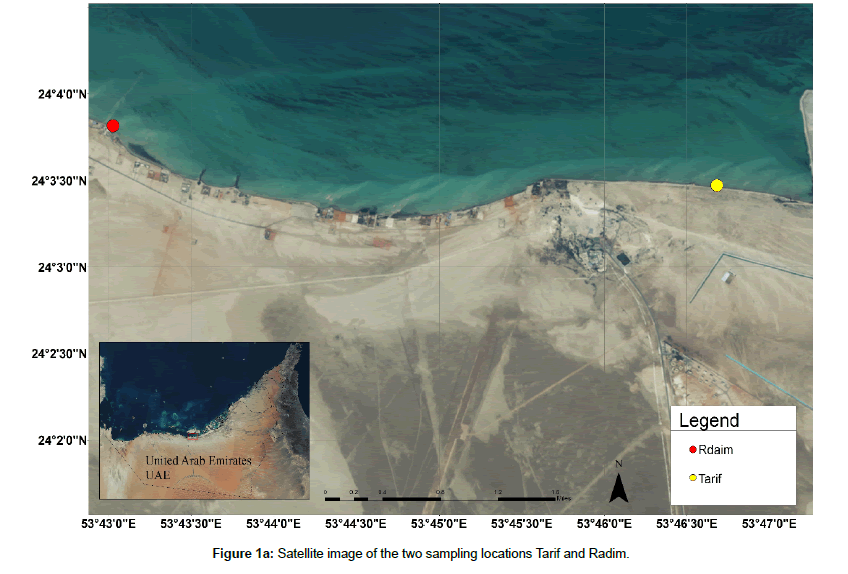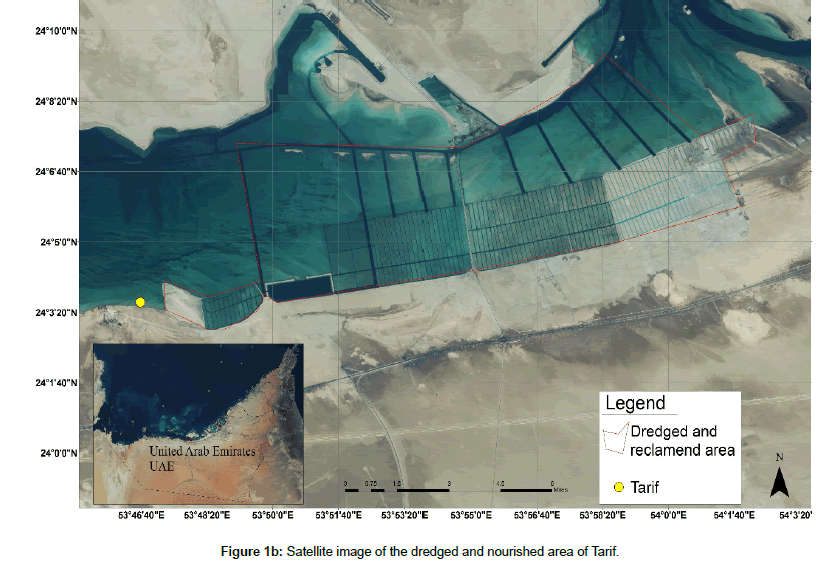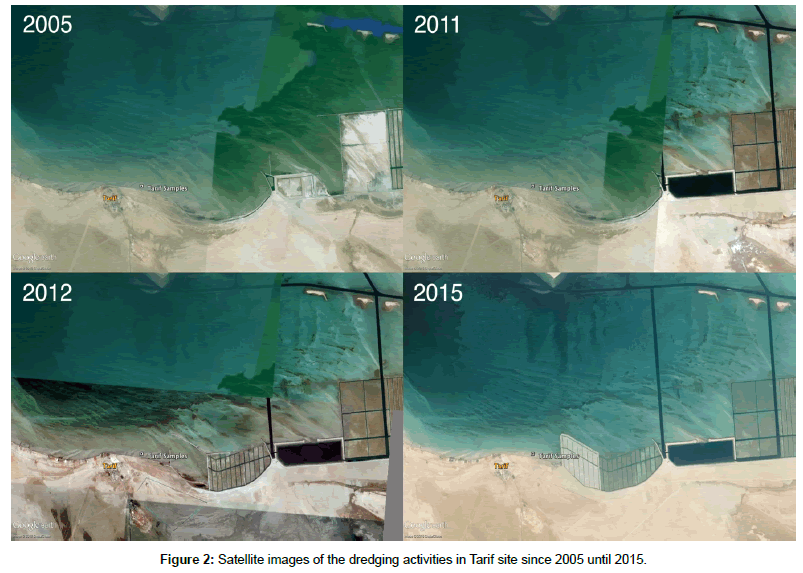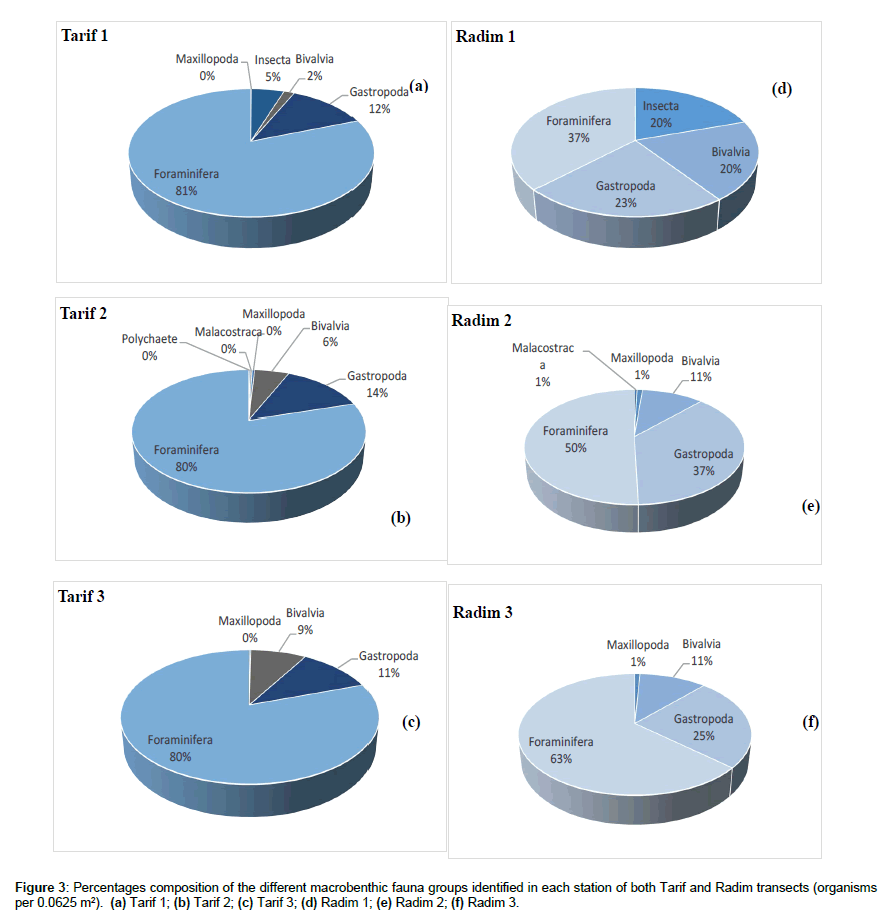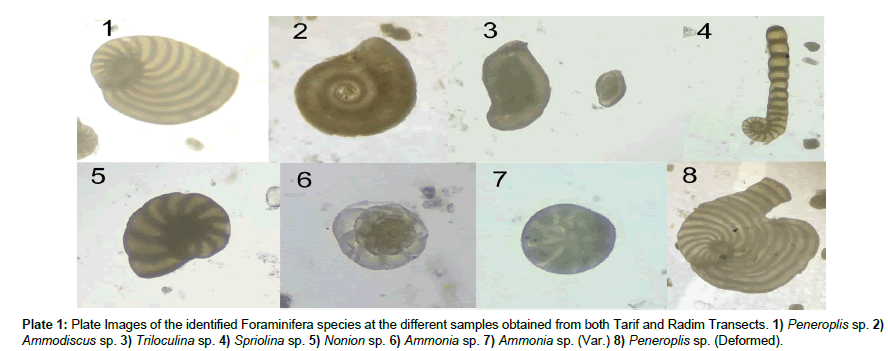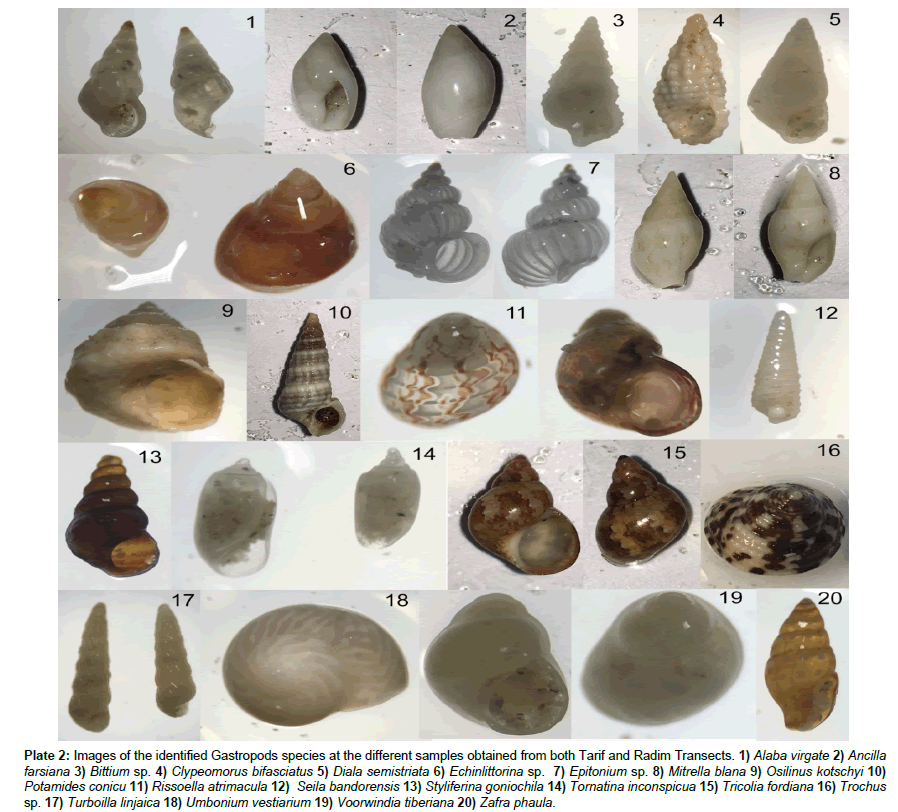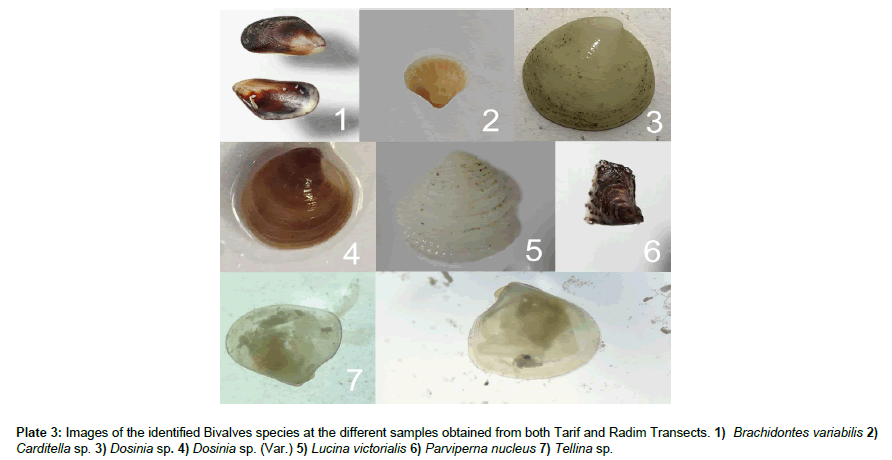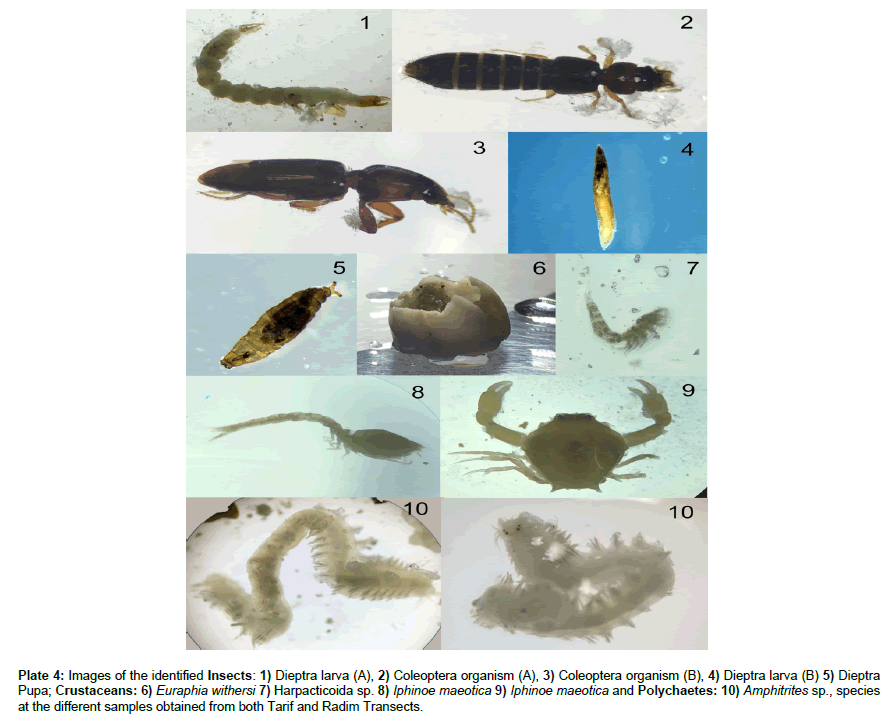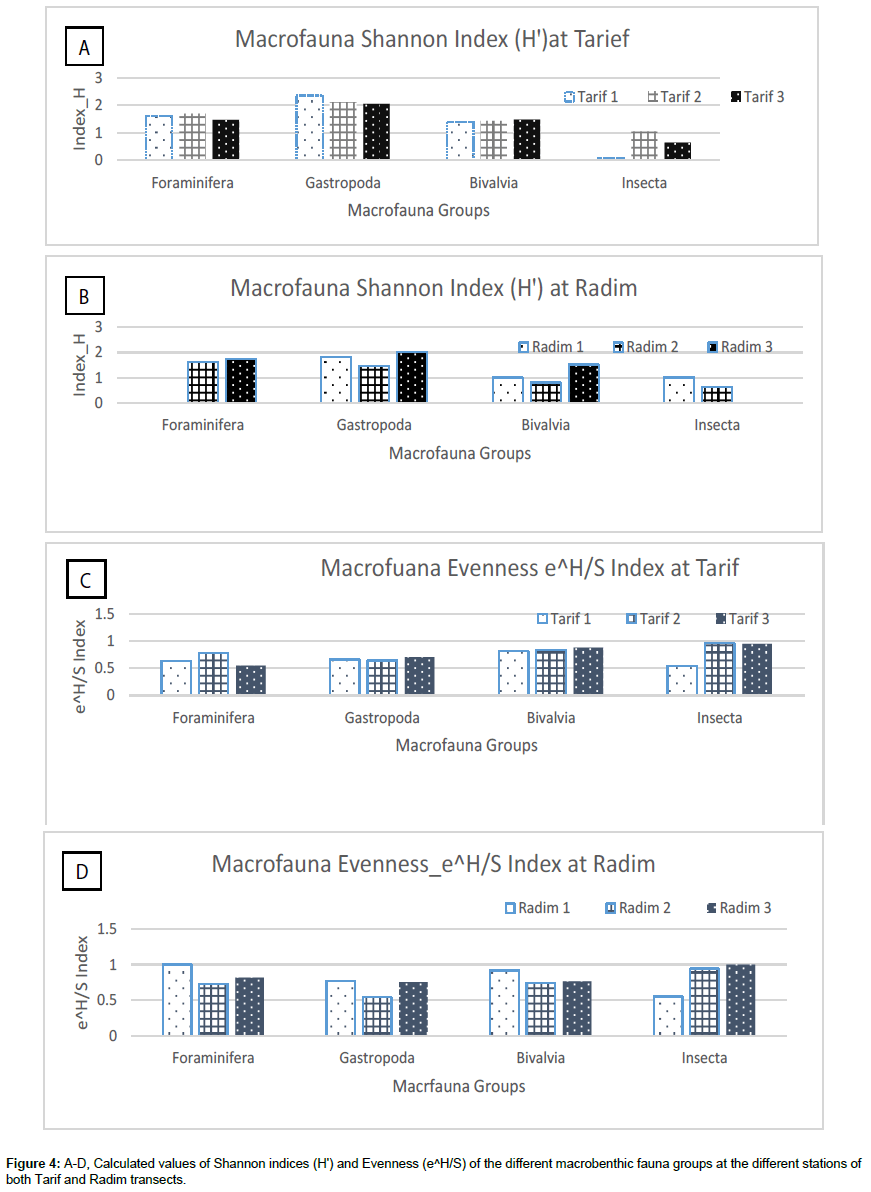Research Article, J Mar Biol Oceanogr Vol: 7 Issue: 1
Coastal Alterations and Its Impact on Diversity of Macrobenthic Fauna in the Intertidal Zone of Abu Dhabi Western Coast (UAE)
Waleed Hamza1*, Shamsa Al Hameli2, Gaber Ramadan1 and Maitha Al Hameli2
1Biology Department, College of Science, United Arab Emirates University, Al Ain, UAE
2Environmental Agency, Abu Dhabi (EAD), UAE
*Corresponding Author : Waleed Hamza
Biology Department, College of Science, United Arab Emirates University, Al Ain-15551, UAE
Tel: +971-50-5638980
E-mail: w.hamza@uaeu.ac.ae
Received: October 09, 2017 Accepted: January 06, 2018 Published: January 12, 2018
Citation: Hamza W, Hameli SA, Ramadan G, Hameli MA (2018) Coastal Alterations and Its Impact on Diversity of Macrobenthic Fauna in the Intertidal Zone of Abu Dhabi Western Coast (UAE). J Mar Biol Oceanogr 7:1. doi: 10.4172/2324-8661.1000183
Abstract
Coastal Alterations and Its Impact on Diversity of Macrobenthic Fauna in the Intertidal Zone of Abu Dhabi Western Coast (UAE)
The community structure of macrobenthic fauna in the intertidal zones at two locations, along the west coast of Abu Dhabi (UAE) have investigated. The two locations, Tarif and Radim, have experienced human impacts represented in coastal alteration due to both dredging and nourishment activities. In each location three sediments samples were collected from a transect that extended from high tide mark on the beach to low tide in the sea direction. Forty-four taxa were recorded that belonging to five groups representing the macrobenthic faunal assemblages in the two locations namely, Foraminifera, Mollusca (Gastropods and Bivalves), Insects, Crustaceans (Maxillopoda and Malacostraca), and Polychaetes. In both locations, Foraminifera dominated the samples followed by Mollusca. The obtained results highlighted the differences in species composition and their distribution not only between the two studied locations but also within the different stations of the same transect. Moreover, the statistical analyses have shown that correlations between grain sizes percentage in the different stations and the percentage composition of the faunal communities in each transect was not significant p = 0.07 in Tarif and p = 0.62 in Radim). The presences of abnormalities in considerable number of the Foraminifera species Peneroplis sp. could be due to its translocation with sediments from stressed environment to the study site. The study showed the extent to which coastal alteration can disturb the established macrobenthic fauna communities and their recovery might extend to several years.
Keywords: Arabian Gulf; Coastal zone; Biodiversity; Grain sizes; Abnormalities
Introduction
The continuous increase of world population and the high demand of luxurious housing and economic projects on coastal areas have resulted in major dredging and reclamation of coastal areas in many developing countries. Such activities have directly altered the natural coastal structures and its living biota. The most impacted component of such ecosystems is the biodiversity of its benthic living communities. Both dredging and nourishment are directly responsible for removing such organisms from their native habitat and transporting them into or out of the coastal environment. Macrobenthos fauna (invertebrates living in or on the sediments that retained from a sediment sample by a 0.5 mm sieve [1]) inhabit the same area throughout their lifetime, which makes them ideal model communities for monitoring ecological status of coastal areas [2-4]. These communities are mainly formed of Polychaetes, mollusks such as gastropods and bivalves; crustaceans such as Maxillopoda and Malacostraca. They are mostly nonimmigrant inhabitants and play a vital role in recycling of organic deposits at the sea sediments [5].
An intertidal zone is part of the seashore and coastal area that periodically submerged by water during highest spring tides and exposed to air by lowest neap tides. These zones are well known worldwide where significant tidal range is considerable. The Arabian Gulf has many peculiar characteristics, where in addition to its high temperature and water salinity a tidal activities ranging between 1-3 m contribute towards stressing its intertidal ecosystems [6,7]. Yet, the shore sediments of the United Arab Emirates show varying degrees of biological diversity; where intertidal sand and mudflats in sheltered regions are high in biological diversity [8].
Although previous studies on Macrobenthic fauna carried out by different researchers in some areas of the Arabian Gulf countries, very few have investigated the intertidal benthic fauna in the coastal area of United Arab Emirates. These studies have mainly identified gastropods and/or bivalves as dominant groups [6,9-12]. While other groups such as foraminifera, polychaetes and insects have almost ignored.
The aim of this study is to investigate the impact of coastal alteration due to dredging and nourishment on the community structure of macrobenthic fauna in the intertidal flats in two neighboring locations in the Western Region of Abu Dhabi, United Arab Emirates (UAE).
Materials and Methods
Study sites
The present study conducted during March 2016, in two neighboring locations named; Tarif and Radim. They are areas located at the western part of Abu Dhabi Emirate (Figure 1a). This area exhibits a low energy coastline and has relatively wide intertidal flats [13]. The two sites are approximately 80 km western of Abu Dhabi city, and 6 km apart from each other (Figure 1b). They have had intensive dredging and nourishment for building up road networks to serve major economic projects related to oil industries.
Satellite images of Tarif location indicate significant dredging and reclamation processes occurred since 2005 until 2015 (Figure 2).
Sample collection
In total, six sediment samples from the two intertidal transects i.e. three sediment samples from Tarif, and three sediment samples from Radim. Tarif 1 and Radim 1 were collected from high intertidal zones (landward), Tarif 2 and Radim 2 were collected from the middle intertidal zone, and Tarif3 and Radim3 were collected from the low intertidal zone (seaward). A polyethylene quadrate frame of 25 × 25 cm and a gardening rake marked at 5 cm sharp edges were used to excavate and collect up to 5 cm depth of the sediments within the frame. The collected samples have placed in labeled plastic containers and kept refrigerated for 48 hours, until being analyzed. Then, the samples washed through a 0.5 mm mesh sieve using a pressure sprayer filled with filtered marine water collected from the same site. The sieved macrobenthic fauna samples were then rinsed individually in 10% neutral buffered formalin for fixation for 5 days. Samples were then preserved in 70% ethanol. Each sample was weighed, and onetenth (10% well mixed portion) of each sample weight for sorting and picking of the existing species. Sorting procedure was performed using a stereo microscope with mounted camera (Olympus D×700). Organisms have picked and separated into different containers according to their taxonomic group. Count of each organism was carried out and referred to the total sampled surface area (0.0625 m2), from each station. After sorting, organisms were photographed and identified to the nearest taxonomic rank using identification keys, illustrated books, and previous scientific studies [14-17]. The remaining sediment samples from each station have then individually spread on separate trays and left to dry at room temperature, then it was oven dried at 80°C for 24 hours. 100 g of well-mixed dry sediments from each sample was sieved over different mesh sieves, using mechanical shaker, to determine its grain size composition.
The obtained results of the identified species and their densities were analysed statistically, using the Paleontological statistical software package [18] to characterize biodiversity indices of the different macrobenthic fauna groups and subgroups using Shannon- Weaver index [19,20]. The differences in grain size fractions and the diversity indices of the different fauna groups at the different stations of each location as well as between similar stations at the two transect were compared using the Two-Way ANOVA analyses [21,22]. The correlations between grain sizes and macro fauna groups at each station and at each location have also computed.
Results
Five main groups of macrobenthic fauna were quantified representing Foraminifera, Mollusca (Gastropods and Bivalves), Insects, Crustaceans (Maxillopods and Malacostraca), and Polychaeta. The most dominant group was Foraminifera (Table 1), where the percentage composition of its organismal densities ranged from 37% in Radim1 up to 81% in Tarif 1 (Figure 3). Peneroplis sp. was, found in both Tarif and Radim transects with high densities i.e. 12,288 organisms in Tarif, and 989 organisms in Radim (Plate 1, Table 1). There were also deformed organisms of the Peneroplis sp. (Plate 1) and its occurrence was higher in Tarif than Radim stations. Gastropods were the most diverse group in Mollusca with 20 identified species (Plate 2), and had the second highest abundance (Table 2). A total of 2,834 organisms of gastropods were found in Tarif, transect stations and 1,924 organisms in Radim transect stations. On the other hand, only seven species of Bivalves (Plate 3), were found in the samples of all stations at both locations (Table 3). 1,499 organisms of bivalves found in Tarif transect, which is double of the density found in Radim, i.e. 751 organisms (Table 3). Bivalve species, Lucina victorialis and Parviperna nucleus, were only found in Rdaim 3. The highest frequency of Insects organisms was insect pupae that mainly found in the Tarif 1 and Radim 1. Species from the Order Coleoptera has only encountered in Radim1 (Plate 4). Crustaceans (Maxillopoda and Malacostraca) and polychaetes (Plate 4) were neither frequent nor diverse in both locations. In Tarif transect the total density of all insects, crustaceans and polychaetes were up to 331 organisms, and only 81 organisms in Radim transect (Table 4).
Plate 2: Images of the identified Gastropods species at the different samples obtained from both Tarif and Radim Transects. 1) Alaba virgate 2) Ancilla farsiana 3) Bittium sp. 4) Clypeomorus bifasciatus 5) Diala semistriata 6) Echinlittorina sp.7) Epitonium sp.8) Mitrella blana 9) Osilinus kotschyi 10) Potamides conicu 11) Rissoella atrimacula 12) Seila bandorensis 13) Styliferina goniochila 14) Tornatina inconspicua 15) Tricolia fordiana 16) Trochus sp. 17) Turboilla linjaica 18) Umbonium vestiarium 19) Voorwindia tiberiana 20) Zafra phaula.
Plate 4: Images of the identified Insects: 1) Dieptra larva (A), 2) Coleoptera organism (A), 3) Coleoptera organism (B), 4) Dieptra larva (B) 5) Dieptra Pupa; Crustaceans: 6) Euraphia withersi 7) Harpacticoida sp. 8) Iphinoe maeotica 9) Iphinoe maeotica and Polychaetes: 10) Amphitrites sp., species at the different samples obtained from both Tarif and Radim Transects.
| Species | Tarif 1 | Tarif 2 | Tarif 3 | Rdaim 1 | Rdaim 2 | Rdaim 3 |
|---|---|---|---|---|---|---|
| Peneroplis sp. | 1,728 | 3,520 | 7,040 | 39 | 260 | 690 |
| Ammodiscus sp. | 494 | 130 | 190 | - | 50 | 60 |
| Triloculina sp. | 559 | 110 | 770 | - | 340 | 470 |
| Spirolina sp. | 120 | 180 | 230 | - | 140 | 780 |
| Nonion sp. | 240 | 20 | 1,450 | - | 50 | 180 |
| Ammonia sp. | 620 | 120 | 850 | - | 220 | 430 |
| Ammonia sp.var. | 12 | - | 30 | - | - | - |
| Peneroplis sp. (deformed) |
80 | 110 | 220 | - | 10 | 240 |
| Total numbers | 3,853 | 4,190 | 10,780 | 39 | 1,070 | 2,850 |
Table 1: Numbers of identified Foraminifera organisms found at the different stations of Tarif and Radim transects (organisms per 0.0625 m2).
| Genus/Species | Tarif 1 | Tarif 2 | Tarif 3 | Rdaim 1 | Rdaim 2 | Rdaim 3 |
|---|---|---|---|---|---|---|
| Alaba virgata | 2 | - | - | - | - | - |
| Ancilla farsiana | 2 | - | - | - | - | - |
| Bittium sp. | 38 | 50 | 170 | - | 20 | 250 |
| Clypeomorus bifasciatus | 46 | 30 | - | 3 | 40 | 50 |
| Diala semistriata | 72 | 50 | 220 | - | - | 100 |
| Echinlittorina sp. | - | - | - | 3 | - | - |
| Epitonium sp. | - | 10 | - | - | - | - |
| Mitrella blana | 8 | 20 | 80 | - | 20 | 20 |
| Osilinus kotschyi | 49 | 70 | 30 | - | - | - |
| Potamides conicus | 66 | 80 | 110 | 8 | 310 | 100 |
| Rissoella atrimacula | 107 | 120 | 110 | 1 | 40 | 60 |
| Seila bandorensis | - | - | - | 1 | - | - |
| Styliferina goniochila | 102 | 230 | 180 | 5 | 300 | 250 |
| Tornatina inconspicua | 23 | 10 | 20 | 2 | 40 | 200 |
| Tricolia fordiana | 1 | - | - | - | - | - |
| Trochus sp. | 32 | 10 | 120 | - | 20 | 50 |
| Turboilla linjaica | 6 | 10 | 10 | - | - | - |
| Umbonium vestiarium | - | - | - | 1 | - | 30 |
| Voorwindia tiberiana | 26 | 40 | 460 | - | - | - |
| Zafra phaula | 14 | - | - | - | - | - |
| Total Number | 594 | 730 | 1510 | 24 | 790 | 1110 |
Table 2: Numbers of identified Gastropods organisms found at the different stations of Tarif and Radim transects (organisms per 0.0625 m2).
| Genus/Species | Tarif 1 | Tarif 2 | Tarif 3 | Rdaim 1 | Rdaim 2 | Rdaim 3 |
|---|---|---|---|---|---|---|
| Brachidontes variabilis | 28 | 130 | 275 | 6 | 80 | 140 |
| Carditella sp. | 5 | 70 | 285 | - | - | 160 |
| Dosinia sp. | 28 | 40 | 210 | 1 | 140 | 105 |
| Dosinia sp. (var.) | 8 | 30 | 40 | - | - | - |
| Lucina victorialis | - | - | - | - | - | 20 |
| Parviperna nucleus | - | - | - | - | - | 10 |
| Tellina sp. | 10 | 30 | 310 | 4 | 10 | 65 |
| Total Number | 79 | 300 | 1120 | 21 | 230 | 500 |
Table 3: Numbers of identified Bivalves organisms found at the different stations of Tarif and Radim transects (organisms per 0.0625 m2).
| Groups | Species | Tarif 1 | Tarif 2 | Tarif 3 | Rdaim 1 | Rdaim 2 | Rdaim 3 |
|---|---|---|---|---|---|---|---|
| Insects | Diptera larva (A) | - | - | - | 1 | - | - |
| Coleoptera insect (A) | - | - | - | 1 | - | - | |
| Coleoptera insect (B) | - | - | - | 1 | - | - | |
| Diptera larva (B) | - | - | - | 18 | - | - | |
| Crustaceans | Dipetra pupa | 247 | - | - | 10 | - | - |
| Maxillopoda | Euraphia withersi | 4 | 20 | 20 | - | 20 | 30 |
| Harpacticoida sp. | - | - | 10 | - | - | - | |
| Malacostraca | Iphinoe maeotica | - | 20 | - | - | - | - |
| Pyrhila biprotubera | - | - | - | - | 10 | - | |
| Polychaetes | Amphitrites sp. | - | 10 | - | - | - | - |
| Total Number | 251 | 50 | 30 | 21 | 30 | 30 |
Table 4: Numbers of identified insects, crustaceans and polychates organisms found at the different stations of Tarif and Radim transects (organisms per 0.0625 m2).
The grain size analysis of the collected samples from both transects has shown that, the highest percentages of the samples grain size were fine sand. The second highest percentages were either medium or very fine sand with the exception of the sample collected from Radim 3 where 52% of the sample was medium sand and the second highest percentage (32%) was fine sand (Table 5).
| Weight (%) | ||||||||||
|---|---|---|---|---|---|---|---|---|---|---|
| Mesh No. | 5 | 10 | 18 | 35 | 60 | 120 | 4 | pan | Wt. | |
| mm | 4 | 2 | 1 | 0.5 | 0.25 | 0.125 | 0.062 | < 0.062 | Wt. | |
| Size Class | Pebble | Granule | Very Coarse Sand | Coarse Sand | Medium Sand | Fine Sand | Very Fine Sand | Mud | ||
| Tarif 1 | 2.76 | 1.23 | 1.3 | 5.11 | 35.27 | 44.37 | 9.82 | 0.1 | 100.0 | |
| Tarif 2 | 0.42 | 0.33 | 0.81 | 3.25 | 13.73 | 46.07 | 33.9 | 1.43 | 99.9 | |
| Tarif 3 | 0.91 | 0.51 | 0.81 | 4.52 | 25.44 | 54.32 | 12.41 | 0.95 | 99.9 | |
| Radim 1 | 0.12 | 0.14 | 0.31 | 0.64 | 10.23 | 62.57 | 25.35 | 0.5 | 99.9 | |
| Radim 2 | 3.15 | 3.46 | 1.2 | 2.63 | 25.99 | 44.33 | 16.54 | 2.48 | 99.8 | |
| Radim 3 | 0.56 | 0.49 | 1.00 | 6.74 | 52.3 | 32.01 | 5.73 | 1.00 | 99.8 | |
Table 5: Grain size analyses of the sediment samples collected from Tarif and Radim stations.
Shannon indices (H') of species of different groups and their evenness (e^H/S), have shown that the diversity at Tarif transect and its stations is higher than that of the Radim ones (Figure 4a-d). Furthermore, the two-way ANOVA analyses between the Shannon indices of all animal groups in corresponding stations of both transects was highly significant p = 0.0097. On the other hand, the two-way ANOVA analyses of the differences between grain sizes percentages of the different stations, collectively or individually, in the two transects has resulted in highly significant values (Table 6). On the other hand, the correlations between grain sizes percentage in the different stations and the percentages of the different animal groups in each transect was not significant (p = 0.07 in Tarif and p = 0.62 in Radim).
| Stations | Sum squares | df | Mean squares | F | p |
|---|---|---|---|---|---|
| Tarif1 # Radim1 | 4899.26 | 7 | 699.895 | 7.975 | 0.0068 |
| Tarif2 # Radim2 | 3694.52 | 7 | 527.788 | 0.00156 | 0.0008 |
| Tarif3 # Radim3 | 4488.73 | 7 | 641.247 | 7.075 | 0.0097 |
| Tarif # Radim | 13082.5 | 23 | 568.805 | 8.806 | 0.00000097 |
Table 6: Summary of the Two-way ANOVA results for the grain sizes variance between the corresponding stations and the overall stations of Tarif and Radim transect samples.
Discussion
Previous studies have indicated that, variations in the community structures, diversities and populations densities of macrobenthic fauna between different locations of intertidal zones resulted from different parameters. These parameters could be water salinity variations, organic contents of sediments, intensity and type of pollution, climate change, and type of sediments grain sizes [5,23-26]. Because of the interference of more than one parameter in determining the community structures and diversity of the inhabiting organisms, it is always difficult to refer such variations to a single component. In the present study, the investigated two locations are just six kilometers distance from each other and they are sharing the same environmental features. In fact, in both locations (Tarif and Radim), few local populations are living with only small commercial activities. The arid nature and the absence of large commercial activities and public services of Western Abu Dhabi Emirate have reduced the density of population living there. However, the high potential of oil reserves have resulted in high intensive constructions of roads network and highways to serve oil industries that located less than 100 km of the studied locations. This developmental plan has led to dredging of coastal areas, where oil fields are in the vicinity and nourishment of beaches as a recovery engineering operation. Such activities started since 2005 until 2015 (Figure 2), and was more intensive in Tarif location. However, in Radim, it seems that due to of its position downward of the local current direction where erosion from Tarif occurred and deposition of sediments in Radim is taking place.
The present study revealed that the groups of the macrobenthic fauna found in both locations were similar. However, the species composition and frequencies of the animals’ community in each station were different between the two studied locations. In Tarif transect, the observed high densities and frequency of the identified foraminifera species, especially in Tarif 3 (Table 1), could be due to either, the high organic contents in sediments of this transect or that these organisms artificially transported during the beach nourishment. In their study, Morigi et al., [27] have found that the increase in benthic foraminifera strongly correlated with organic matter. This was not the case in Radim transect, (Figure 1). As shown in Table 1, the number of the dominated species (i.e. Peneroplis sp.) in Tarif stations were almost 50-100 times more than in the corresponding Radim stations. This may lead to hypothesize that foraminifers found in Tarif in high densities may not belonging to that area and its presence in Radim stations may result from long shore current transportation with suspended sediments. As mentioned earlier, both Tarif and Radim have very low human population densities and all the development there was related to roads constructions to serve Oil industries in that area. On the other hand, the presence of abnormalities in the coiling and the shape of the chamber of some organisms belonging to the foraminifera species Peneroplis sp. (Plate 1), with high densities in Tarif compared with that in Radim can confirm the above hypothesis. In his study, Youssef [28] related abnormalities in two foraminifera species (i.e. Sorites marginalis and Peneroplis planatus), found in the coastal areas of the Red Sea (Jeddah-Saudi Arabia), to either natural stress or the high trace metals concentration. He added that these trace metals (Fe, Mn, Cu, Pb, Ni, Cr and Cd), may result from anthropogenic activities. It is well known that, Abu Dhabi Emirates is occupying more than 68 % of the total surface area of the United Arab Emirates [7], and its western area is known to hold the second largest Sabkha Matti embayment in the world, where the two studied areas are close to it. The high salt contents in the transported nourishment sand to Tarif and its associated trace metal impurities could be responsible about the abnormalities in foraminifera. Especially, when salts dissolved by the seawater at the intertidal area. A possible speculation here, that these nourishment materials with foraminifers’ organisms were dredged or excavated from other areas that subjected to natural stress due to high salinity of Sabkha or its high trace metals contents.
By comparing the Mollusca group (Gastropods and Bivalves), densities and its diversities at the different stations of the two transect, it is clear that Tarif has more abundant and more diversified species. In general twenty (20) gastropod species and five (5) bivalves species were found in Tarif transect, while only 11 species of Gastropods and 6 bivalves species were found in Radim Transect (Tables 2 and 3). The presence of higher number of bivalves species in Radim transect (six species) than those found in Tarif (5 species), could be attributed to differences in grain size of bottom sediments. Although, the statistical analyses have revealed insignificant correlations between sediments grain sizes and percentage composition of the macrobenthic communities in the two transects, in Tarif 1, sediments yielded 44% fine sand (0.125mm), and 35% medium sand (0.25mm), where, species diversity and density were significantly high. While in Radim 1, where 62% was fine sand and 25% was very fine sand very poor community was recorded (Tables 2 and 3). The presence of the two bivalve species, Lucina victorialis and Parviperna nucleus, only in Radim 3 where 52% of the sediment was medium sand may suggest the linkage between these two species with the medium sand percentage in sediments.
The high gastropod diversity of this study confirms previous studies in the region. In Qatar, 99 gastropods had reported as one of the most dominant macrobenthos in the intertidal zone by Al-Khayat [29]. Moreover, Hasan [30] investigated the Saudi Arabia intertidal zones along the Arabian Gulf and identified 62 species of gastropods. The numbers of Gastropods identified in our study were less due to the small area from which they were collected and due to the dredging activities that could be responsible about the removal of significant part of the existing communities. Even so, the identified species of gastropods found to be compatible with other investigations around the Gulf intertidal areas.
Regarding the other groups of Macrobenthic fauna identified in the present study (i.e. Insects, Crustaceans and Polychaetes); their numbers and diversity were very poor. For example, insect larvae and pupae only found in stations Tarif 1 and Radim 1 (Table 4). The identified pupae and larvae belonged to two taxonomic orders Diptera and Coleoptera. Species from the Order Coleoptera have only found in Radim1; the reason might be that its coastal gentle slope makes it more exposed to dry periods than Tarif, which allow those insects to lay their eggs. On the other hand, Radim 1 station lacked both crustaceans and polychaetes in its sediments. Moreover, only two crustacean species (Euraphia withersi and Pyrhila biprotuera), were identified in the sediments of the other two stations of Radim transect, but no polychaetes were recorded. Strikingly, three crustacean species recorded within Traif stations (Table 4), and one polychaete species (Amphitrites sp.), was found only in Tarif 2. Although it is obvious that Tarif transect stations are more rich and diversified than Radim ones, both transects are considered poor in numbers of these three groups. This may be a result of the intensive dredging and nourishment activities occurred in those two locations for the past 10 years. Where, the substitution of original cluster of sediments with anomalous structure of sediments not only different in grain size but may be also in its chemical composition could have negative effect on the established biota. In their study, Seiderer and Newell [23], found that modification of sediment composition from mixed sands and gravels to silt in dredge borrow sites would result in a replacement of a community comprising a wide variety of relatively long-lived and slow growing species by a small variety of opportunistic species capable of survival in mobile deposits. In fact, in the present study, other macrobenthic fauna groups such as, echinoderms, large crustaceans and Hydrozoa never found in the collected samples of either location. Moreover, the polychaete group only represented by Amphirites sp. that found in Tarif 2. This confirms the displacement of the original sediments and the disturbing environment in the studied area, which prevent the faunal community from establishing and reaching equilibrium. The grain size analyses of the different stations from the two sampling transects of this study have shown three major fractions which are medium sand, fine sand and very fine sand, that explained up to 90% of the collected sediments samples. While Pebbles, granules, very coarse sand, and mud explained the other 10%. This may also suggest that, the nourishment sediments could be transported from a well sorted coastal location close to the studied area.
It becomes clear from the present study that coastal alteration by either dredging and/or nourishment can result in translocation or disappearance of living faunal communities. Consequently, the reestablishment of such communities needs some times to reach climax. The necessary time may vary according to different factors, which may not only be sediments grain sizes, but also organic contents, water salinity, biological competition and other anthropogenic factors. It has mentioned that, changes in community composition occurred in both experimentally dredged and un-dredged sites took 3 years to reach similar community composition [31]. In natural conditions, such as in Tarif and Radim dredged areas that may take more time to reach ecological stability.
References
- Link JS, Griswold CA, Methratta ET, Gunnard J (2006) Documentation for the Energy Modeling and Analysis eXercise (EMAX). Massachusetts (MA), NOAA, USA.
- Nasser H (2011) Human impacts on marine Biodiversity: Macrobenthos in Bahrain, Arabian Gulf: The importance of biological interactions in the study of biodiversity. INTECH publisher, Rijeka, Croatia.
- Medrano M (2015) Diversity Of Macrobenthic Invertebrates In The Intertidal Zone Of Brgy. Tapangahoy, Tubay, Agusan Del Norte, Philippines. Int J Eng Res Appl 19: 5-9.
- Wei CL, Rowe GT, Al-Ansi M, Al-Maslamani I, Soliman Y, et al. (2016) Macrobenthos in the central Arabian Gulf: a reflection of climate extremes and variability. Hydrobiologia 770: 53-72.
- Tabatabaei T, Amiri F (2011) Evaluation of the impact of industrial sewage pollution on marine benthic communities. J Water Supply Res Technol-Aqua 60: 364-375.
- Feulner GR, Hornby RJ (2006) Intertidal Molluscs in UAE Lagoons. Tribulus 16:17-23.
- Hamza W, Munawar M (2009) Protecting and managing the Arabian Gulf: past, present and future. Aquat Ecosyst Health Manag 12: 429-439.
- Hellyer P, Aspinall S (2005) The Emirates: A Natural History. Trident Press, Cape Town, South Africa.
- Nabavi SMB, Salari-Aliabadi MA, Shamoradi AR, Vazirizadeh A, Arebi I (2011) Ecological Assessment of Intertidal Ecosystems in Khark Island (Persian Gulf) Using Community Structure of Macrobentic Bivalves. World J Fish Marine Sci 3: 559-563.
- Kohan A, Badbardast Z, Shokri M (2012) The Gastropod Fauna along the Bushehr Province Intertidal Zone of the Persian Gulf. J Persian Gulf 3:33-42.
- Shivanagouda N, Bhat UG (2013) Study of Abundance and Distribution of Sub tidal Macrobenthic Diversity in near Shore waters off Gulf of Kutch, Gujarat, India. Res J Marine Sci 1: 2321-1296.
- El-Sorogy A, Youssef M, Al-Kahtany K, Al-Otaiby N (2016) Distribution of Intertidal Molluscs along Tarut Island Coast, Arabian Gulf, Saudi Arabia. Pakistan J Zool 48: 611-623.
- EAD (2011) Abu Dhabi Environmental Atlas. Environmental Agency of Abu Dhabi. Eye on the Earth, UAE.
- Cherif OH, Al-Ghadban A-N, Al-Rifaiy IA (1997) Distribution of Foraminifera in the Arabian Gulf. Micropaleontol 43: 253-280.
- Al Abdessalaam TZ (2007) Marine Environment and Resources of Abu Dhabi. (1st edtn), Environment Agency Abu Dhabi, Abu Dhabi, UAE.
- Bosch DT, Dance SP, Moolenbeel RG, Oliver PG (1995) Seashells of Eastern Arabia. (1st edtn), Motivate Publishing. Dubai, UAE.
- Al-Yamani F, Skryabin V, Boltachova N, Revkov N, Makarov M, et al. (2012) Illustrated Atlas on the Zoobenthos of Kuwait. (1st edtn), Kuwait Institute for Scientific Research, Kuwait.
- Hammer O, Harper DAT, Ryan PD (2001) PAST: Paleontological statistics software package for education and data analysis.
- Shannon CE, Weaver W (1963) The mathematical theory of communication. University of Illinois Press, Urbana.
- Adams SM (2003) Biological indicators of aquatic ecosystem stress. American Fisheries Society, USA.
- Yates F (1934) The analysis of multiple classifications with unequal numbers in the different classes. J Am Stat Assoc 29: 51-66.
- Gelman A (2005) Analysis of variance? Why it is more important than ever. Ann Stat 33: 1-53.
- Seiderer LJ, Newell C (1999) Analyses of the relationship between sediment composition and benthic community structure in coastal deposits: Implications for marine aggregate dredging. ICES J Mar Sci 56: 757-765.
- Bu-Olayan AH, Thomas BV (2005) Validating species diversity of benthic organisms to trace metal pollution in Kuwait Bay, Off the Arabian Gulf. Appl Ecol Env Res 3: 93-100.
- Saunders JS, Al Zahed KM, Paterson DM (2007) The impact of organic pollution on the macrobenthic fauna of Dubai Creek (UAE). Mar Pollut Bull 54: 1715-1723.
- Koblentz KE, Henkel JR, Sigel BJ, Taylor CM (2015) Influence of sediment characteristics on the composition of soft-sediment intertidal communities in the northern Gulf of Mexico. Peer J. 3: e2014.
- Morigi FJ, Jorissen A, Gervais S, Guichard A, Borsetti M (2001) Benthic Foraminiferal faunas in surface sediments off NW Africa: relationship with organic flux to the ocean floor. J Foraminiferal Res 31: 350-368.
- Youssef M (2015) Heavy metals contamination and distribution of benthic foraminifera from the Red Sea coastal area, Jeddah, Sauidi Arabia. Oceanologia 57: 236-250.
- Al-Khayat JA (2005) Some macrobenthic invertebrates in the Qatari waters, Arabian Gulf. Qatar Univ Sci J 25: 126-136
- Hasan KA (1996) A Taxonmic Review of the Bivalve and Gastropod Mollusk Fauna Along the Saudi Intertidal Zone of the Arabian Gulf. J KAU Mar Sci 7: 245-253.
- Kenny AJ, Rees HL, Greening J, Campbell S (1998) The effect of marine gravel extraction on the macrobenthos at an experimental dredge site off North Norfolk, U.K. (Results 3 years post-dredging). ICES-CM 1998/V:14.
 Spanish
Spanish  Chinese
Chinese  Russian
Russian  German
German  French
French  Japanese
Japanese  Portuguese
Portuguese  Hindi
Hindi 